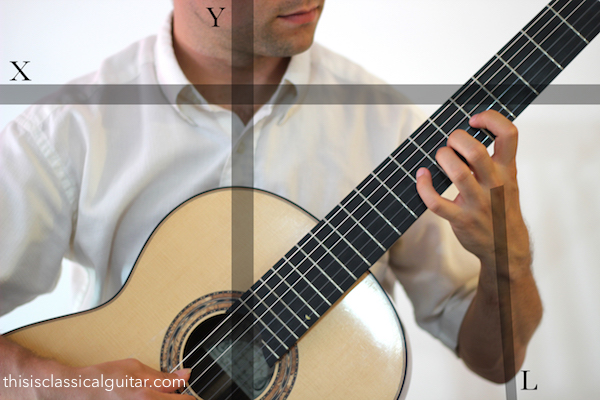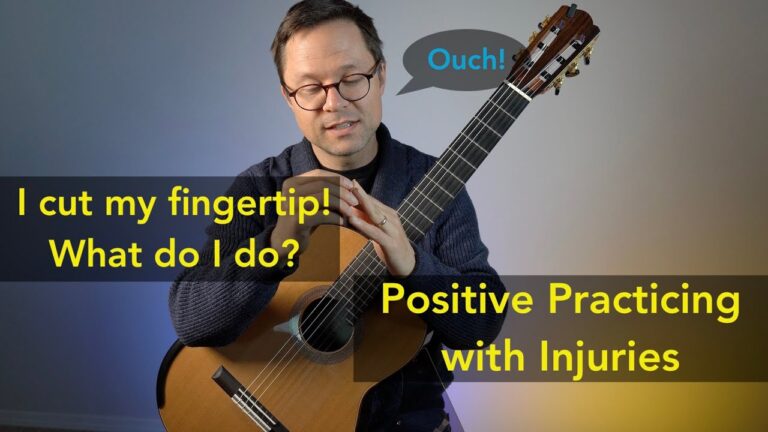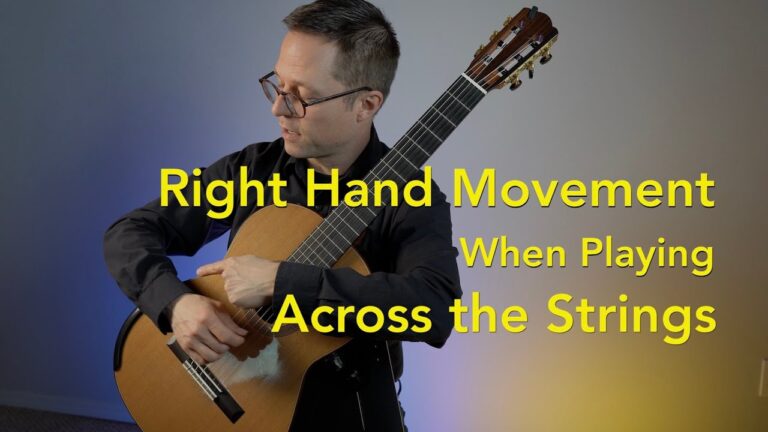
Learn to play classical guitar with these beginner and intermediate lessons. This page is mainly a classical guitar for beginners curriculum but also brings students into the intermediate level. Learn classical guitar today with this free classical guitar course. If you don’t have an instrument yet, check out our classical guitar gear page.
Learn Classical Guitar – Lessons for Beginners
Before you begin to learn from any books you should look at these lessons to cover some basics.
- Step 1: Lessons for Your Guitar and Hand Positions
- Basic Technique Overview Video – Slideshow of Photos, Tips, & Diagrams
- Sitting Position for Classical Guitar – Video, Photos, Tips, Diagrams
- Right Hand Position for Classical Guitar – Video, Photos, Tips, Diagrams
- Left Hand Position for Classical Guitar – Video, Photos, Tips, Diagrams
- Tips and Advice for Beginner Classical Guitarists – Video, connects the above lessons
Learn to Read Music and Play Songs on Classical Guitar
- Classical Guitar Method Book Vol. 1 by Werner – Free 100 page PDF method with 20+ video lessons for beginners. Focus is on reading music and playing melodies and arpeggios. This is my fully free beginner guitar course.
- Classical Guitar Method Book Vol. 2 by Werner – Solos, duets, chords songs, 15+ video lessons. The main focus is on reading in different keys but also introducing slurs, half barres, rhythm, and some upper positions.
Learn More Classical Guitar Essentials
- Fingernail Lesson for Classical Guitar
- Playing Musically on Classical Guitar
- Right Hand Tone Production
- Slurs on the Classical Guitar
- Right Hand Fingering Lesson Parts 1-4
- Right Hand Planting & Preparation
- Left Hand Preparation
Learn to Play Technique and Intermediate Pieces on Classical Guitar
- Classical Guitar Repertoire Lessons Grade 1 – Eight pieces at the grade one level with dedicated lessons preparing you for each piece.
- Classical Guitar Repertoire Lessons Grade 2
- Classical Guitar Repertoire Lessons Grade 3
- Classical Guitar Repertoire Lessons Grade 4
- Classical Guitar Technique by Werner – Essential exercises, scales, and arpeggios.
- 20 Favorite Exercises, Notation + TAB, Video lessons, Gr.1-6, Great for crossover or a quick boost.
- Ten Classical Etudes – Ten progressive etudes from the classical era with video lessons. Grade 4-7.
Learn Right Hand Technique Essentials for Classical Guitar
These are exercises with lessons from my technique book but all the videos are free to watch and demonstrate many techniques and exercise that you can copy and learn from for free.
- Technique Routines (Discussions on Time Management)
- Beginner Technique Routine
- Late-Beginner Technique Routine
- Early-Intermediate Technique Routine
- Intermediate Technique Routine
- Late-Intermediate Technique Routine
- Early-Advanced Technique Routine
- Part 1 – Right Hand Exercises
- Right Hand Open String Exercises with i, m, a (No. 1-19)
- Right Hand Open String Exercises with p,i,m,a (No.20-35)
- Preparation (Planting) in the Right Hand
- Open String Exercises No. 36-71
- Open String Exercises No. 72-100
- Giuliani’s 120 Right Hand Studies
- Part 2 – Left Hand Alignment, Shifts, and Scales
- Alignment Exercises for the Left Hand
- Chromatic Scale Exercises
- Variations and Ideas for Practicing Scales
- Open Position Scales Through the Circle of Fifths
- One Octave Moveable Major Scales
- Shift and String Squeak Exercises
- Favourite Two and Three Octave Moveable Scales
- Major Scales with Open String Shifts
- Triadic Arpeggios
- Part 3 – Slurs, Finger Independence, and Stretch
- Slur Exercises (Hammer-ons, Pull-offs)
- Selected Slur Scales
- Left Hand Independence, Alignment, and Stretch
- Selected Major Scales in 3rds, 6ths, Octaves, and 10ths
- Part 4 – Additional Techniques
- Barre Exercises
- Tremolo Exercises
- Basic Rasgueado
- Common Natural and Artificial Harmonics
- Speed and Relaxation
General Advice
- Music is special so always play thoughtfully and with musical feeling
- Music is easy but requires daily practice to improve
- Enjoy fixing your mistakes and solving problems
- End each practice session with a piece you can play well
Practice Tips
- Practicing is problem solving (not just playing)
- Always check your technique before playing
- Carefully consider fingering and instructions before playing
- Practice the music slowly at first (half speed or less)
- Practice difficult parts slowly and repeatedly in small sections
Sitting Position (see full article)
- The head of the guitar is at eye level (guitar is at 45º angle)
- Feet flat on the ground and footstool
- Face of guitar straight up and down (not angled back)
- Relax shoulders and neck
Right Arm & Hand (see full article)
- Right arm touches the guitar just in front of the elbow
- Right wrist is straight with a relaxed arch
- Right hand plays above the rosette
- Right hand fingers move into the palm, not up and away
- Right hand thumb is in front of the fingers
Left Arm & Hand (see full article)
- Left wrist is straight, not over-extended
- Left palm and knuckles are parallel with the strings
- Left hand thumb is vertical and behind 2nd finger
- Left hand fingers are curved and on fingertips
- Left hand fingers play very close to the fret
Happiness in small goals: Making your practice sessions enjoyable will be key to long-term musical success and development. When experiencing difficulties, break up the piece or exercise into small manageable goals at a speed you can accomplish successfully. Even if you only play a few notes at a time, playing successfully will improve your skills and give you a feeling of accomplishment.
Isolate difficulties and solidify strengths: Balance your practice sessions by working on difficulties as well as maintaining easy material you can play well. Playing at a high quality level as often as possible will help develop a solid foundation. Work on your difficulties near the middle of your practice session and finish with something you can play well. This will ensure you end with a positive feeling of success.
Practicing is Problem Solving: Practicing is different than just playing the guitar. When you practice you need to identify problems or elements you wish to improve and solve them immediately. Simply playing the guitar will not make you a better musician. If your teacher says you should practice for 30 minutes a day, be sure you are actually practicing for 30 minutes not just playing.
Combine repetition with thoughtful practice: Although a certain amount of repetition is required to establish your skills, balance repetition with thoughtful reevaluation. Sometimes, improvement will occur by reexamining your posture, hand positions, or elements not directly connected to what you are studying. Having a qualified teacher is very helpful. They can identify problems before you repeat it a hundred times. That said, aim to be mindful at all times about what you are doing.
Good days vs bad days: Actually, I don’t believe in good or bad practice days. All days are good opportunities to practice something. On days when you are having trouble focusing or executing material cleanly, slow down your speed and use a metronome until you are playing well. You may have to play at half the speed you intended but you can still get in some quality practice.
Play slowly: I’ve rarely encountered a student who practices as slowly as I think they should. Practicing ultra slowly will ensure you are playing with your best hand positions, sound, confidence, relaxation, accuracy, and more. The majority of your practicing should be at very slow tempos. Once you can play something well at a slow tempo, you can speed it up while keeping an eye on the quality level.
Page markers: Use page markers (sticky tabs) on the pages you are practicing so you can quickly flip to the next piece or exercise.
Keep it simple: Even the most advanced players will practice simple open string exercises but will do so at a very high quality level. Quality practice helps to improve your playing so keep the exercises and pieces simple enough that you can accomplish them at your highest potential. You don’t have to prove yourself to anyone. You‘ll only improve if you set realistic and manageable goals.
Trust your teacher: If your teacher recommends something contrary to what’s in this book, please trust their advice. Your teacher knows what’s best for you and your personal and unique development. Learning from books and online videos can be helpful but the real work is done through long-term communication with teachers and other musicians.




